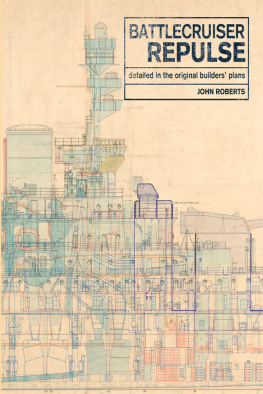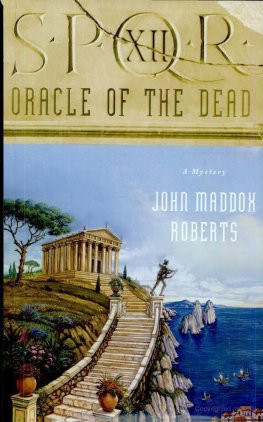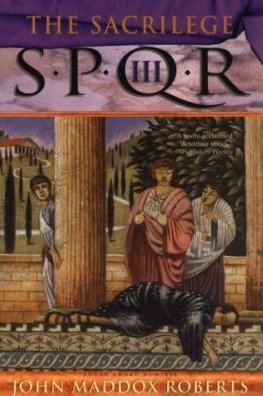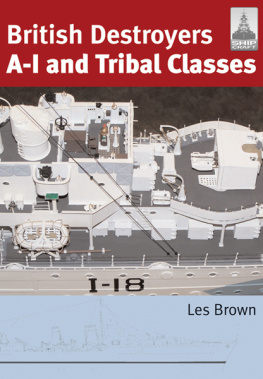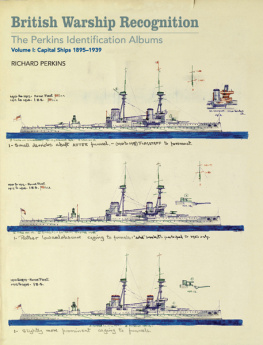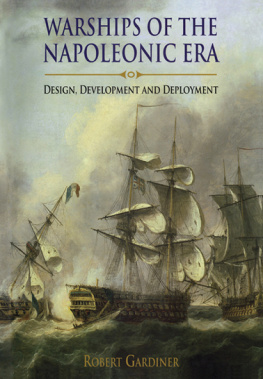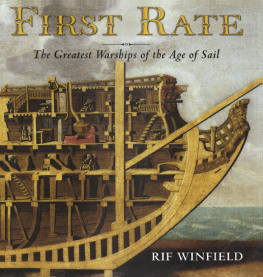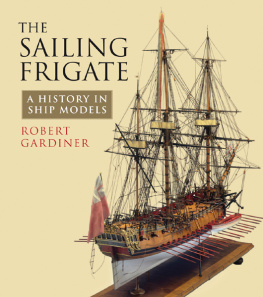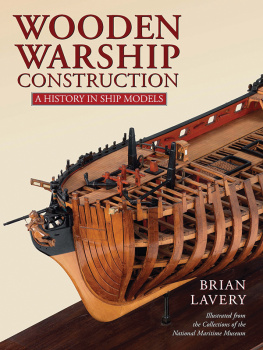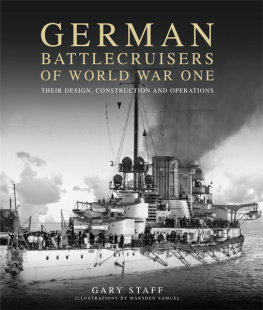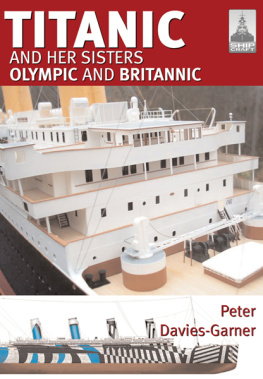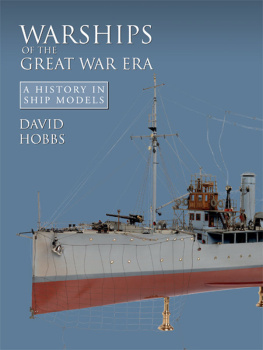
Half title image : The eagle-and-rock badge was carried by HMS Repulse for the vast majority, if not all, of the ships career, which is attested to by photographs of the tompions and the bridge front. The field is usually blue, although there is one surviving example with the field painted red. There is some uncertainty because the battlecruisers successor, the Polaris-armed SSBN, had an entirely different badge, described heraldically as: blue field; castle gold, on which flies the Union Flag, proper, on two wavelets, silver. The ships motto Qui tangit frangitur translates as Who touches me is broken. A E Weightmans Heraldry in the Royal Navy lists the castle design as earlier than the eagle, but the official sealed design shows the eagle, with pencil annotations dated 8/7/41 saying NOT TO BE USED and See new badge. This may suggest that the battlecruiser was due to be assigned the new castle badge just before she was sunk. ( Drawing by Stephen Dent )
Frontispiece : Repulse as fitted 1936, conning tower deck ( National Maritime Museum, Greenwich (part of J9434)
Copyright Seaforth Publishing 2019
Ship plans National Maritime Museum, Greenwich
This edition first published in Great Britain in 2019 by
Seaforth Publishing,
An imprint of Pen & Sword Books Ltd,
47 Church Street,
Barnsley
South Yorkshire S70 2AS
www.seaforthpublishing.com
Email:
Published in association with Royal Museums Greenwich, the group name for the National Maritime Museum, the Royal Observatory, the Queens House and Cutty Sark .
British Library Cataloguing in Publication Data
A catalogue record for this book is available from the British Library
ISBN 978 1 5267 5728 9 (Hardback)
ISBN 978 1 5267 5730 2 (Kindle)
ISBN 978 1 5267 5729 6 (ePub)
eISBN 978 1 5267 5729 6
Mobi ISBN 978 1 5267 5730 2
All rights reserved. No part of this publication may be reproduced or transmitted in any form or by any means, electronic or mechanical, including photocopying, recording, or any information storage and retrieval system, without prior permission in writing of both the copyright owner and the above publisher.
Pen & Sword Books Limited incorporates the imprints of Atlas, Archaeology, Aviation, Discovery, Family History, Fiction, History, Maritime, Military, Military Classics, Politics, Select, Transport, True Crime, Air World, Frontline Publishing, Leo Cooper, Remember When, Seaforth Publishing, The Praetorian Press, Wharncliffe Local History, Wharncliffe Transport, Wharncliffe True Crime and White Owl.
ACKNOWLEDGMENTS
This book owes more to co-operation between publisher and author than is normally the case and on that basis my thanks are due to both Robert Gardiner of Seaforth Publishing, who was responsible for creating this series in the first place, and to Steve Dent for his considerable skill in the books design and the occasional corrective comment.While most of my text is based on research gathered over a lengthy period and not originally linked to this project, I would also like to express my considerable gratitude to Andrew Choong and Jeremy Michell of the Photograph and Ship Plans Department of the National Maritime Museum, Greenwich for the assistance and friendly cooperation they have provided for me over many years. Lastly, I owe thanks to Jean, my wife, who has always been supportive of my apparently insane obsession with the details of warship design and has never regarded the Royal Navy as a rival!
ORIGINS
D uring the decade before 1914 the most influential personality in the development of British warship design was Admiral Sir John Fisher (1st Sea Lord 19041910). His forceful and positive approach served to accelerate the rate of technical advance generating what was to become known as the dreadnought revolution. While the Dreadnought may have initiated this revolution, it actually encompassed a much broader range of technological, strategic and tactical ideas than those simply concerned with battleship construction. Fishers undoubted genius and foresight brought substantial advantages to British naval administration and development but his faith in the correctness of his views on ship construction contained the danger of assuming that their success was a foregone conclusion. Foremost among his pet schemes was the introduction, in parallel with Dreadnought , of the all-big-gun armoured cruiser of which three ( Invincible, Inflexible and Indomitable ) were included in the same 190506 Construction Programme. These ships followed Fishers obsessive belief that high speed in warships was of paramount importance. His demands for priority in speed were employed with religious fervour whenever an opportunity to express his vision presented itself. In effect he saw the Indomitable class, which were 4 knots faster than Dreadnought , as the basis for the capital ships of the future. He did not view their considerably lighter protection as a problem or see that many of the advantages of high speed would be lost if matched by new ships of a potential enemy. His essential requirements were for speed and gun-power. Armour followed up a poor third, utilising whatever weight was available on the displacement allowed by the financial limitations of the time.
Fisher was a master of employing persuasion, intrigue and threats (usually to resign) to get his own way but he was not all-powerful and was dependent on the support of both his political masters and the senior officers of the Admiralty. In consequence there was no change in construction priority and the battleship remained the primary unit of fleet power. Consequently the construction programmes for 190607 and 190708 included no armoured cruisers, in part due to political demands for economy. For much the same reason the 190809 Programme included only one battleship and one conventional armoured cruiser with 9.2in guns. However, at this point in time Germany embarked on a substantially increased warship construction programme that included her first all-big-gun armoured cruiser (the German designation was groen kreuzer = large cruiser), Von Der Tann , laid down in March 1908. This initiated the pre-war naval race between Britain and Germany which began in earnest in 1909 and gave Fisher his chance to press again for ships that would outclass their rivals in both speed and gun-power.With the need for economy overridden by the threat to Britains naval supremacy the next three programme years provided for the construction of 14 battleships and 6 armoured cruisers size steadily increased, gun calibre was stepped up from 12in to 13.5in and, in the case of the 13.5in-gunned armoured cruisers, speed raised to 28 knots. In 1911 the all-big-gun armoured cruisers were officially re-designated battle cruisers.
When Fisher stepped down as 1st Sea Lord in January 1910 he had not achieved his prime objective in regard to speed. All the battleships constructed during his tenure of office retained the standard 21-knot speed of Dreadnought while the speed of the armoured cruisers more-or-less equalled rather than exceeded contemporary German designs. However, being out of office did not put him out of the picture and he continued to campaign for those items of naval administration, strategy and technology that he viewed as critical to the continuation of British naval supremacy. His efforts were substantially enhanced when Winston Churchill, having been appointed 1st Lord of the Admiralty in October 1910, solicited his advice.This developed into a close relationship in which Fisher provided guidance on a variety of naval subjects including his strong views on the advancement of ship design. Even here, however, Fisher failed to win round either Churchill, or possibly the Board of Admiralty via Churchill, to his view that the heavily armed battlecruiser, with a speed substantially in excess of foreign contemporaries, was an essential fleet requirement. The last of the pre-war battlecruisers, Tiger of the 191112 Programme, demonstrates the relatively limited extent of Churchills application of Fishers views in the adoption of a modification of the machinery design to allow sufficient overload power to provide a design speed of 30 knots (in practice she could not achieve more than 29 knots). The fact that none of the remaining pre-war construction programmes included a battlecruiser also serves to indicate the Admiraltys loss of confidence in the value of the type which resulted in the introduction of the fast battleships of the Queen Elizabeth class in the 1912 Programme. These ships were intended to serve as the fleets fast wing but not for the cruiser functions (scouting and trade protection) assigned to the battlecruisers. The only points in which they fulfilled Fishers desires were a further increase in gun-power by adopting the 15in calibre and the provision of oil fired boilers. It is worth noting that late in 1911 Fisher was advocating the adoption of the same eight-gun 15in armament for a 30-knot battlecruiser design it is not clear if this proposal served to initiate the development of the 15in gun or that his choice of calibre was simply prompted by some inside knowledge of developments at the Admiralty. Any doubt in regard to the immediate pre-war capital ship construction policy of the Admiralty is provided by the programmes of 191314 and 191415.The former consisted of the five 15in gun, 21-knot Royal Sovereign class battleships and the latter of three more slightly modified vessels of the same class and a single repeat of the Queen Elizabeth design.Thus by 1914 Fishers battlecruiser concept was as good as dead but fate, in the shape of the outbreak of war in August 1914, was to intervene and allow him to initiate the construction of exactly what he wished for.

